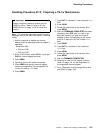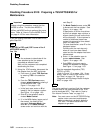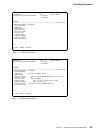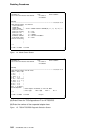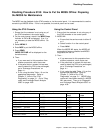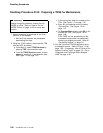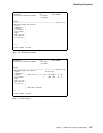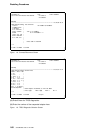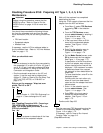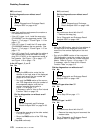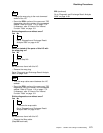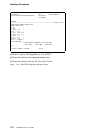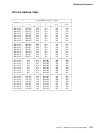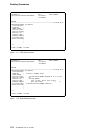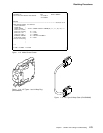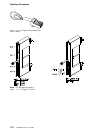
Disabling Procedures
Disabling Procedure 0150: Preparing LIC Type 1, 3, 4, 5, 6 for
Maintenance
Important
Before using this procedure, ensure that the
MOSS is online. Refer to “How to Put the
MOSS Online” on page 4-105 for more infor-
mation.
You should have recorded the following informa-
tion from the reference code and from the addi-
tional information (PF6) for use during this service
call.
FRU and location
Suspected adapter
Affected lines.
If necessary, use the LIC/Line address tables to
find the affected lines. Refer to “LIC/Line Address
Table” on page 1-73.
What you should do next:
001
– Ask the customer to stop the lines connected to
the suspected LIC or pair of LICs for LIC type 5
and 6. A LIC pair is an odd numbered LIC plus
an even numbered LIC. Refer to the IBM 3745
Connection and Integration Guide.
– Run the automatic wrap test on the LIC unit
(option 1) and the wrap test at tailgate level
(option 2). Refer to “How to Run the Wrap Test
(WTT) for TSS, HPTSS, or 3746-900” on
page 3-15.
Did you get the message: 'Wrap test com-
pleted. The LIC is OK'?
Yes No
002
Go to Chapter 4, “3745 FRU Exchange” on
page 4-1, then exchange the LIC card.
003
Has “Disabling Procedure 0120: Preparing a
TSS/HPTSS/ESS for Maintenance” on
page 1-62 already been performed, or is the
3745 fully available?
Yes No
004
Ask the customer to deactivate all the lines
attached to the suspected adapter.
Wait until the customer has completed
deactivating the lines.
Using the 3745 console, disconnect the line
adapter from the NCP as follows:
a. From Menu 3, select TSS Services
by entering TSS in the selection
area.
b. From the TSS Services screen,
choose select/release by entering 1
in the selection area. See
Figure 1-11 on page 1-74.
c. In the input area, enter an S fol-
lowed by the suspected adapter
number. See Figure 1-12 on
page 1-74.
d. Enter 3 in the selection area to
choose Mode Control. See
Figure 1-11 on page 1-74.
e. On the Mode Control screen, enter
DS to disconnect the line adapter.
See Figure 1-13 on page 1-75.
If deactivation of all the lines driven
by this line adapter was not done, a
screen showing active lines will be
displayed. If the customer is unable
to deactivate these lines, request
his approval to force deactivation for
these lines.
To force deactivation, enter F on the
displayed screen.
Continue with the next action only
when all lines have been deacti-
vated and the line adapter has been
disconnected.
f. Enter 1 in the selection area to
choose select/release. See
Figure 1-11 on page 1-74.
g. Enter REL in the input area to
release the disconnected line
adapter. See Figure 1-13 on
page 1-75.
Continue with Step 005.
005
– Run the concurrent TSS diagnostics using the
number of the suspected adapter. Refer to
Figure 1-10 on page 1-72.
If necessary, refer to “How to Run Internal
Function Tests” on page 3-9.
(Step 005 continues)
Chapter 1. START: How to Begin Troubleshooting 1-69



